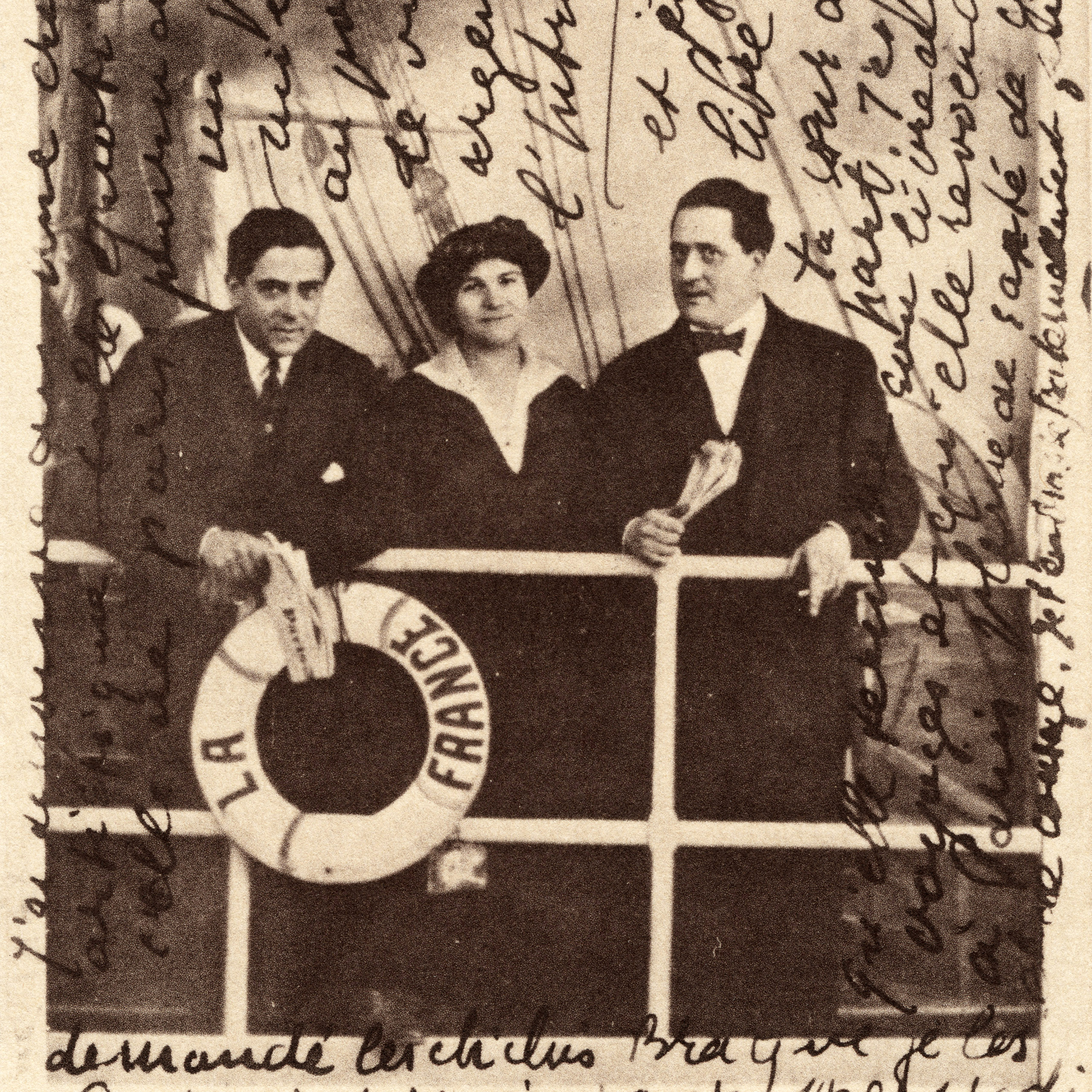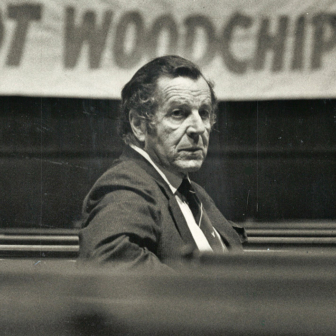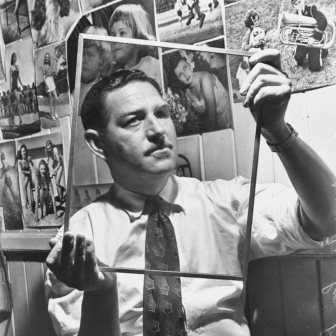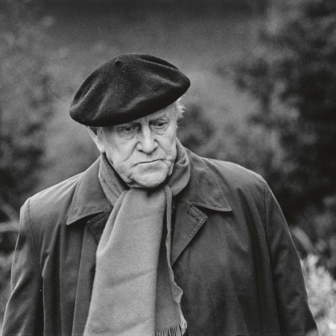Gabriële Buffet met Francis Picabia on a warm autumn evening in Verseilles in 1908. She was a gifted musician, he a successful painter like Gabriële’s brother Jean. Jean was taking his friend to meet his sister but, as we shall see, Francis was the unlikeliest of suitors. Less than a year later, though, the musician had married the painter, and thus was forged one of the most fruitful partnerships in the development of twentieth-century art.
At this point we might ask fruitful for whom, but we’d be jumping ahead of ourselves. The obstacle at that first encounter was Gabriële’s passion to become a composer. She’d secured a place dedicated to avant-garde music in the Schola Cantorum, and progressed from there to Berlin, where she played in bistros and orchestras to earn her keep while she drank in the pleasures of the city and unleashed the creativity of her mind.
She enrolled in courses conducted by one of the city’s modernist composers, who urged his students to “explore abstract sonorities” while paying due attention to aesthetic developments in other artforms. Gabriële was a staunch modernist and Francis, whose imitative, Sisley-inspired, neo-Impressionist canvasses were being shown in all the top Parisian galleries, seemed to have little to recommend him.
For Gabriële Buffet was the classic bluestocking. The future she had mapped for herself precluded marriage and motherhood, and at twenty-seven she was still happily a virgin. Nor was she what a casual observer might call fetching.
“There’s nothing sweet about Gabriële Buffet’s face,” write Anne Berest and Claire Berest in Gabriële. “Her chin, especially, is too large. Her forehead, too. Her eyes are narrowed in perpetual thought, like two coal-black slits beneath strongly marked brows that obscure the colour of her irises.” Yet, they continue, “This woman, neither beautiful nor ugly, is something else.”
And Francis Picabia? “Small, slim” with “smouldering dark eyes,” even then he was a notorious womaniser known for the huge amounts of money he wasted on cars. I’d venture that their improbable union was the attraction of opposites, yet to do so is to make a travesty of that truism. But whatever it was, their story, as the Bisset sisters craft it, raises all kinds of questions. What do we really know about sex, love, ego, parenthood, feminism — and, not the least of it, art?
As it happened, Gabriële and Francis did spend that night together. But it was not the easy sexual adventure Picabia had expected. Instead, they spent the hours talking. He, the authors’ great-grandfather, had never come across a woman like their great-grandmother. He had reached an impasse in his art, he confided to her, but was tied down by exhibitions and contracts. To this she replied: “What you paint should be purely a creation of the mind conceptualising it.” It was the bold remark that gave him the courage he needed.
Gabriële’s intelligence thrilled him more than any sexual conquest could. “Encirclement” is what the Bisset sisters call it. From that moment, her mind became both his inspiration and his treasure. She gave up music to embrace, “without apparent frustration, a career as a maieutic, that is, a sort of muse for the creative processes of others.”
This most madcap of madcap unions was possible, it should be said, by their both being beneficiaries of family fortunes. Picabia sold off his old canvasses and exhibited new ones inspired by Gabriële. Then they dashed off to Spain, where “capricious fate knits [them] together.” As Gabriële herself wrote, “I note these details of our time in Spain… because once we’d returned to Paris, they served for years to inspire the themes of compositions by Picabia that were nonetheless entirely abstract.”
Back home, Picabia threw himself into painting, his fading eyesight propelling him further into the new aesthetic. His breakthrough was Rubber, a completely non-representative canvas:
With Rubber, the fruit of Gabriële’s musician’s mind, Francis Picabia paints one of the very first “abstract” paintings — if not, according to some historians, “the first abstract work in the history of art.” Without knowing it, and certainly without ever claiming it, Gabriële has established herself as a “figure at the forefront of the artistic movement.”
Picabia’s reputation was consolidated in 1913 at New York’s groundbreaking Armory exhibition, which introduced America to Cubism. Revelling in the newfound fame, he stayed on for most of the war years. Fuelled by opium, addictive sex and what today would be diagnosed as bipolar disorder, his output was as enormous as his prodigality. Gabriële, meanwhile, gave birth to the first of their four children. The youngest, Vincent (conceived just before their divorce in 1930, and dead by his own hand at just twenty-seven), was the grandfather the Bissets never knew.
Such was the Picabia–Buffet partnership that divorce never entirely succeeded in breaking their hold on each other. If the mind, as has been said, is the most powerful sexual organ, it could hardly be more so than in this coupling.
The book their great-grand-daughters have given us encompasses their contributions to twentieth-century art and includes a cast of equally intriguing characters, Marcel Duchamp, Guillaume Apollinaire, Jean Arp, Tristan Tzara and Pablo Picasso among them. They both lived long lives, Picabia to seventy-four and Gabriële to 104.
As well as her copious writing on art and her intellectual midwifery to so many artists, Gabriële played a documented part in the French Resistance. There was so much to this woman, it is scarcely possible to touch on it in the space I have here. So it’s not at all surprising to learn that the Bisset sisters will be bringing out another volume to cover the latter years of their truly remarkable forebear.
But there’s something else to consider. Like its eponymous subject, a novel written by two sisters is, in its way, groundbreaking. But is it really a novel? When I started writing them, novels were prescribed as long, linear, fictional works portraying the intertwined stories of a set of imagined characters. Now, thankfully, we have novels that blithely dismantle that narrative arc. There are novels as well about historical figures, and some that mix real people with imagined ones.
In Gabriële, though, the authors also break into their story to tell the readers the difficulties they’ve had in writing it. And if all the characters, including the authors, are real, isn’t this more a biography than a novel, especially with a long bibliography at the end? And does any of this matter if the story engages us? To the French anyway, Gabriële is a roman vrai.
Claire Berest has published five other novels, including Rien n’est Noir, which featured the artist Frida Kahlo. Anne Berest’s widely acclaimed sixth book, La Carte Postale, published in English as The Postcard, is based on the sisters’ Jewish grandmother, the daughter of the fourth child of Gabriële and Francis Picaria. Both The Postcard and Gabriële were inspired by the authors’ search for their origins, The Postcard’s protagonist being their grandmother Myriam Rabinovitiz, a Holocaust survivor.
Part of my interest in these works comes from my own impulse in writing two novels based on what I could learn about my mother’s family. The second also involved the arrival of a mysterious postcard. Encountering the same difficulties as the Berest sisters have, I chose to call that book a novel, changing my relatives’ names and inventing a host of other characters. But again — what does any of this matter? What matters are the stories, and in Gabriële Buffet-Picaria’s case, what a richly rewarding story it is.
For all that, what her great-granddaughters have told me so far about Gabriële Buffet’s life has left me wondering. How could a woman with such gifts and dedication to her art give up everything to foster the career of an exasperating wastrel, however handsome and charming? Just toss it away — not even in her case in a fog of hormones — to a talent arguably far less than hers?
To pose the question might simply mean I’m overlooking the impact misogyny had in her day, even on a spirit such as hers. Or am I guilty of minimising the contribution she made in using her prodigious intellect to formulate in words what the arts have in common, how they fertilise each other and, in the last analysis, their tremendous gift of depth and meaning to so many of our lives. •
Gabriële
By Anne Berest and Claire Berest | Translated by Tina Kover | Europa Editions | $34.99 | 350 pages




